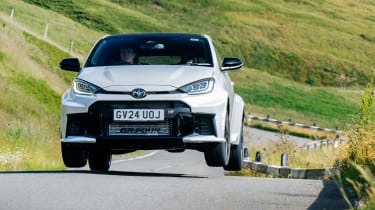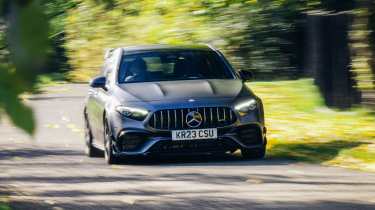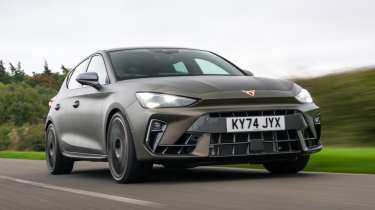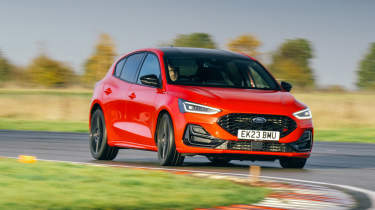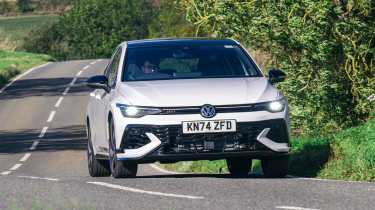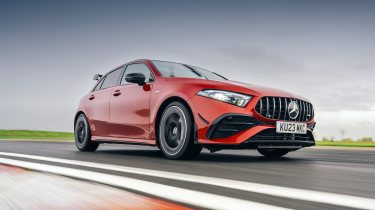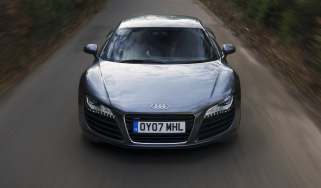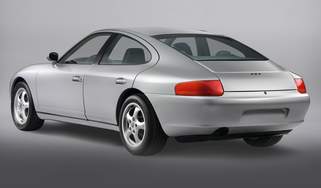Best hot hatchbacks 2025 – you can still buy a great hot hatch
Contracted though the hot hatch market may be, there are still some great models out there, from the electric Alpine A290 to the five-cylinder Audi RS3
The hot hatch has had a rough run over the last few years, with tightening emissions regulations and slim profit margins claiming Renault Sport and Peugeot Sport wholesale, the Ford Fiesta ST, Hyundai’s brilliant i20 N, i30 N and Abarth’s petrol-powered 595 and 695. Even ‘warm’ hatches have fallen, like the Volkswagen Up GTI and soon, the Suzuki Swift Sport.
It’s not all doom and gloom, of course. Signs of life for the hot hatch in an electric future come courtesy of the new Renault 5-based Alpine A290, which while it has a little way to go, is an encouraging tentative step along the way. Likewise Mini’s John Cooper Works e and indeed, the upcoming (still petrol-powered) ordinary Mini John Cooper Works. There’s also the Abarth 500e, with its exuberant-sounding augmented ‘exhaust’ sound.
The updated Toyota GR Yaris is as excellent as ever, even at its heightened price, while the Honda ivic Type R endures. The Volkswagen group persists too, with a new Golf R and GTI Clubsport, while Audi’s RS3, S3 and the Cupra Leon are refreshed ready for 2025 too.
Having extensively tested every current hot hatch, we've come up with a list (in no particular order) of the models you should shortlist in 2024.
Best hot hatchbacks 2024
- Honda Civic Type R
- Toyota GR Yaris
- Mercedes-AMG A45 S
- Cupra Leon 300
- Ford Focus ST Performance
- Volkswagen Golf GTI Clubsport
- Mercedes-AMG A35
- Alpine A290 GTS
- Audi RS3
Honda Civic Type R
- Star rating 5
- Price from £50,050
- Honda Civic Type R review
Honda's FL5 Civic Type R hasn't disappointed. Yes, its hardware is very similar to the previous FK8 model, but everything from the engine, gearbox, chassis and suspension has been further honed to within an inch of perfection.
The FL5 feels more like a super touring car than a hot hatchback, with a low, flat cornering stance and a level of clarity and precision you’d expect from a bespoke sports car. The Civic’s 2-litre turbocharged engine revs cleanly and pulls hard throughout the rev band, but it could do with a little more aural excitement to accompany the performance. And the manual gearbox? Still one of the best available at any price.
It’s difficult to find many weaknesses in the package, but the Type R’s £50,050 price tag does sting a little. Context is important, though, because a well-specced Golf R can cost over £50k, and the AMG A45 S is £13k more expensive. The Honda feels more special and rewarding than both.
Toyota GR Yaris 'Gen 2'
- Star rating 5
- Price from £44,250
- Read our Toyota GR Yaris review
The GR Yaris had quite some pressure on its pumped up haunches leading up to its arrival in 2020. It was the first genuine WRC homologation road car in decades – a bespoke, highly tuned, finely wrought performance machine that many anticipated would become an icon, even before its wheels hit the tarmac. Thankfully, the GR Yaris turned out to be as brilliant as we’d hoped, and Toyota couldn’t build enough of them.
This meant that Toyota could justify launching a heavily revised Gen 2 version to build on the attributes that made the original great. The new car has the same tenacious character but with added bite and precision, and with a 276bhp three-pot driving through a revised four-wheel drive system, it’s noticeably quicker than before.
But aside from its giant-killing performance, it’s the GR Yaris’s unique, competition-derived DNA that separates it from conventional hot hatches. Few other performance cars have the same built-for-purpose feel.
Mercedes-AMG A45 S
- Star rating 4.5
- Price from £63,445
- Read our Mercedes-AMG A45 S review
Mercedes-Benz didn’t start the hot hatchback game off particularly well with the original A45 AMG. It was certainly powerful, trading blows with the Audi RS3 for the title of hottest hot hatchback, but it was too inert to be considered a truly great performance car. The same cannot be said for the latest A45 S though, as this model is as far removed from its predecessor as you could possibly imagine.
Gone is the harsh wooden-like suspension and numb steering, in their place a supple feel and an interactive chassis when the right modes are selected. With more power under the bonnet (415bhp), it’s even faster than its predecessor, too.
In some ways, the A45’s adjustability and rear-led balance feels more like an old Mitsubishi Evo than a conventional hot hatch, and when the road allows, it’s hard not to become absorbed in the ferocity of that engine.
Cupra Leon 300
- Star rating 4
- Price from £41,465
- Read our full review of the outgoing Cupra Leon 300
In recent years, Seat (now Cupra) has been able to squeeze just a little bit more out of the same ingredients than Volkswagen with its Golf GTI. The Cupra Leon 300 is a case in point; compared to the Mk8 GTI, it’s more exciting and energetic to drive with a greater sense of fun. It also has a rapid turn of speed thanks to a 2-litre turbocharged engine with 296bhp.
That engine is paired to a crisp-shifting DSG gearbox that allows easy access to the engine’s potential. The Cupra isn’t an especially great communicator – certainly not compared to the likes of the Civic Type R – but its clean, accurate steering makes it easy to place on the kind of technical roads that hot hatches thrive on. The standard Dynamic Chassis Control is great too, allowing you to tailor the ride to the demands of the road surface but not to the detriment of platform control. While not the last word in interactivity, it feels more alive than any Mk8 Golf GTI yet produced.
The recent facelift has also given it a more ‘Cupra’ identity, too, which is handy in the fight to have it seen as more than a hot Seat. On the inside it’s a bit sharper too with an updated infotainment system and praise be, physical controls on the steering wheel.
Ford Focus ST Performance
- Star rating 4
- Price from £37705
- Read our Ford Focus ST review
The Focus ST has never shone quite as brightly as its smaller Fiesta sibling, but now that the latter has been taken off sale, it represents the only way to experience Ford’s signature hot hatch flavour. The ST feels ‘switched on’ at all times, with super quick steering and a tendency to rotate aggressively on a trailing throttle. This ultra-keen feel defines the Focus’s character.
It’s not for everyone, however. Sometimes, you’ll wish the Focus was a touch calmer and more natural in its responses, and it lacks the breadth of the now-discontinued Hyundai i30 N. There’s no denying that the performance is gutsy enough to warrant the ST badge, though, with Ford’s 2.3-litre four-pot kicking out 276bhp and 310lb ft of torque. It doesn’t zing at the top end like a traditional hot hatch, but the snappy manual gearbox makes it easy to keep the motor in its sweet spot.
Ultimately, the Focus feels at its best on track, where you can use the direct front end and highly adjustable balance to extract the most from it. On the road, the firm, connected ride can be wearing, so too the ST’s propensity to torque steer.
Volkswagen Golf GTI Clubsport
- Star rating 4
- Price from £42,155
- Read our 2024 VW Golf GTI Clubsport review
The Mk8 Golf GTI didn't quite hit the spot like its predecessor did and while the Mk8.5 facelifted Golf GTI moved things in the right direction, it’s to the Golf GTI Clubsport that we look to as the best hot Golf Volkswagen currently makes. Credit where it’s due, it does address to an extent the questionable ergonomics, with physical wheel controls, a better screen and revised software. But it doesn’t go far enough to revive some of the genius of the much missed Mk7.
Clubsport spec yields extra power, with the EA888 producing 296bhp and 273lb ft here. Unlike the Golf R, that power goes to the front wheels via the seven-speed DSG and a tweaked e-LSD. It, like the Leon, features dynamic chassis control which works to its benefit but overall, even the best Mk8 doesn’t yet match the heady highs reached by even a middling Mk7 GTI as a driver’s car. It’s a much better hot hatch in the traditional sense than any Mk8 GTI to date, but we know there’s more on the table.
It is a stronger overall package however – the ultimate remit of any GTI. It’s fast and easy to drive day-to-day, while also offering a level of adjustability and grip to entertain when the mood takes you.
Mercedes-AMG A35
- Star rating 4
- Price from £46,000
- Read our Mercedes-AMG A35 review
The Mercedes-AMG A35 might look almost identical to the A45 S, but it’s less expressive, less exciting and not as explosive to drive. That’s to be expected, though. This car operates at a much lower price point than the flagship, and when judged with that in mind, it’s worthy of a spot on this list.
Against the Mk8 Volkswagen Golf R, the Mercedes wins out for its more upmarket feel and sense of fun. With a 302bhp turbocharged four-cylinder engine it achieves an swift 4.7sec 0-62mph time, and while it doesn’t have the A45’s clever torque vectoring rear diff, it deploys its power cleanly with a slight sense of adjustability at the rear.
Climb inside and the A35 has a glitzy, tech-packed interior, but it’s one that can be frustrating to use unless you’re intimately familiar with the UI. The infotainment system is controlled via a central touchscreen and haptic steering wheel pads, and we wish there were a few more physical controls to make it easier to operate on the move.
Alpine A290 GTS
- Star rating 4
- Price from £38,000
- Read our Alpine A290 GTS review
There’s a lot riding on the A290 – the future of Alpine, the future of the French hot hatch and the future of hot hatches as a whole. For as much as it follows in the footsteps of other highly-decorated machinery from Dieppe – the Renault Sport Megane R26.R is an evo all-time favourite – it also leads the charge, so to speak, for the hot hatch as a breed, if it is to experience a resurgence going into an uncertain new era.
Here is a car whose power, performance and dynamics have been very carefully judged, to deliver a potent if not uproarious small sporty electric car, that isn’t compromised at the point of real use. That’s to say, it still rides well, it’s still (relatively) light, it still has usable range and it’s still practical. No, 217bhp in top level A290 GTS trim isn’t spectacular, nor the 6.4sec 0-62mph time. But 1479kg is a commendably low mass figure and 236 miles is an adequate maximum range.
So how is it? In a word, good… if not outstanding. Judged by the standards of its forebears, it is a lukewarm, slightly inert device. Judged by comparison to contemporary machinery like the Abarth 500e and Mini Cooper SE, it’s a big step in the right direction – lighter, better to drive, with more range and with a really engaging design. It does have a sense of humour, it does have dynamic polish. The R5 is a car Renault was very careful to get right. Alpine has taken a similar approach, albeit erring on the side of caution.
Audi RS3
- Star rating 4
- Price from £59,510
- Read our 2025 Audi RS3 review
The Audi RS3 has always been a bit of a charming pariah in the hot hatch arena. Its 2.5-litre turbocharged engine is bewitching but it’s never been attached to a car that can match it for addictive charms. Happily, over the years, Audi has committed to its hyper hatch with incremental updates, edging it closer and closer to a balanced all-round star. But even this latest model with its revised chassis can’t quite match the granular tactility of the likes of the Honda Civic Type R as a devoted driver’s car.
It remains devastatingly fast of course, managing 0-62mph in under four seconds thanks to its 394bhp, 369lb ft, all-wheel-drive and dual-clutch transmission. On top of that the engine that lends the RS3 all that shove is still a joy. It’s also a much more balanced, neutral car than early RS3s ever were. You can play with the RS3 to under or oversteer depending on your inputs. It’s controlled and devastatingly effective on track, in acceleration, braking and cornering. But it does take speeds appropriate only on track, for the RS3 to really come alive.
The optional (£2000) carbon bucket seats get you closer to the action of course and indeed being an Audi, it’s a proper quality item with which to interact. In its genre of hyper-hot hatch, it and the Mercedes-AMG A45S are without peer, even for £60k.


